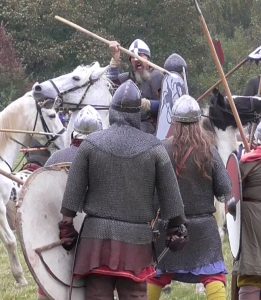 As with most of our information concerning the 11th century, the definition of Housecarl is open to interpretation. Once again I turn to the book “Anglo-Saxon Military Instititions” by C.Warren Hollister for my article; this scholarly work is the most comprehensive I have found on the subject.
As with most of our information concerning the 11th century, the definition of Housecarl is open to interpretation. Once again I turn to the book “Anglo-Saxon Military Instititions” by C.Warren Hollister for my article; this scholarly work is the most comprehensive I have found on the subject.
Interestingly, the Housecarls as a defined group of warriors apparently only existed in 11th century pre-conquest England. Patterned after the Jomsvikings of Denmark (founded by King Harold, father of Swein Forkbeard), they are first mentioned in relation to King Canute—probably in 1018—and ceased to exist as an organization after the Battle of Hastings. It is believed they were in essence a military guild, with a body of regulations and the ability to call up a gemot or huskarlesteffne in the king’s presence to settle disputes or punish a transgressor. If a member of the guild wanted to leave the organization, they could only do so on New Year’s day. In 1049, when Swegn Godwineson killed his cousin Earl Beorn, the King and all the here (housecarls, thegns, even peasants) called a gemot and declared Swegn a nithing. This was a very judicial function, and under Canute’s rule the law states that he “shall be driven off the king’s estates with nithing’s word, and shall be exiled from every land.”
The Housecarls were the closest thing to a paid, standing army (or household troops) one would find in late Anglo-Saxon England. They were loyal to their employer, the king or great earl, and were usually composed of Danish or English professional soldiers. When Harold Godwineson unexpectedly had to go north to stop Harold Hardrada in September 1066, the Housecarls were the only warriors he could initially call upon; the fyrd joined him en route.
Occasionally they were used as tax collectors. Many of their number were landowners. It appears that as the years progressed, the Housecarls started to become a more generic designation, and the word began to be used synonymously with hiredmenn or hired and finally lithsmen and butescarls. The latter two are warriors that can fight equally well on both land and shipboard. In the end, perhaps it can only be said with real assurance that they were all mercenaries or retainers.
Highly trained warriors, the Housecarls mostly fought on foot although it is more than possible that they were perfectly capable of fighting on horseback. Snorri Sturluson tells us in Heimskringla that Harold’s mounted troops attacked the disorganized Norwegians in the early phase of the Stamfordbridge battle. They would not have attacked head-on like we picture in the 14th century battles; rather they would veer past the enemy and launch javelins into their foes’ ranks, much like the Normans did at Hastings. Then they would dismount and finish the battle on foot. During the Battle of Hastings, Harold most likely spread out his Housecarls along the shield wall to support the less experienced fyrd; their ranks had been thinned by Stamfordbridge. Armed with their long Danish axes, the Housecarls would have been a formidable sight. As seen in the Bayeux Tapestry, they could take down both rider and horse with one sweep of their awesome Danish axe. It was a testament to their—and the Anglo Saxon—valor that it took a whole day for William’s well-armed force to break their ranks.